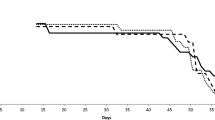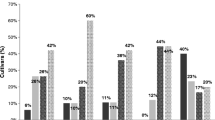Summary
The susceptibility of rice plants of different ages toHelminthosporium disease was studied by conducting artificial infection tests on three different dates during the season. Three varieties, 2 susceptible and a resistant were included in the study. It was found that the susceptibility increased with age of plants and the relative susceptibility of varieties, as compared between plants of the same age remained the same at any time during the season. Inoculations carried out in September produced the maximum infection.
Susceptibility to Blast disease at different ages was studied in 2 field experiments. It was found that younger plants were most susceptible and the resistance increased as the plants grew older. Only the post-planting age of the plants had an effect on their susceptibility.
Similar content being viewed by others
References
Anderson, A. L., Henry, B. W. and Tullis, E. C. “Factors affecting infectivity, spread and persistence of Piriculariaoryzæ Cav.Phytopathology, 1947, 37,2, 94–110.
Hashioka, Y. “Studies on the mechanism of prevalence of the rice blast disease in the tropics,”Tech. Bull. No. 8,Taiwan Agri. Res. Inst. Taipeh, China, 1950, 80–84.
Lowther, C. V. “Seedling resistancevs. adult plant susceptibility of Mentana wheat to race 15 B ofPuccinia graminis tritici,”U.S. Dept. Agr. Plant. Dis. Repr., 1951,35, 480–81.
Padmanabhan, S. Y., Raichoudhury, K. R. and Ganguly, D. “Helminthosporium disease of rice, I. Nature and extent of damage caused by the disease,”Indian Phytopathology, 1948,1, 1, 34–47.
Peturson, B. “Adult plant resistance of some oat varieties to physiologic races of crown rust,”Canad. J. Res. C. 1944,22: 287–89.
Sherf, A. F., Page, R. M., Tullis, E. C. and Morgan, T. L. “Studies on the factors affecting the infectivity ofHelminthosporium oryzæ,”Phytopathology, 1947,37, 281–90.
Suzuki, H. “Reaction of invasion of the blast flungus into rice plant to the difference of susceptibility of them,”Agri. and Hort., 1940,15, 1999–2010.
Tapke, V. F. “Further studies on Barley powdery mildew as influenced by environment,”Phytopathology, 1953,43, 3, 162–66.
Tisdale, W. H. and Johnston, C. O. “A study of smut resistance in corn seedlings grown in the green house,”Jour. Agr. Res. (U.S.), 1926,32, 649–68.
Author information
Authors and Affiliations
Additional information
Communicated by Shri R. L. M. Ghose,f.a.sc.
Rights and permissions
About this article
Cite this article
Padmanabhan, S.Y., Ganguly, D. Relation between the age of rice plant and its susceptibility to Helminthosporium and blast diseases. Proc. Indian Acad. Sci. 39, 44–50 (1954). https://doi.org/10.1007/BF03050372
Received:
Issue Date:
DOI: https://doi.org/10.1007/BF03050372




